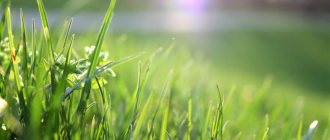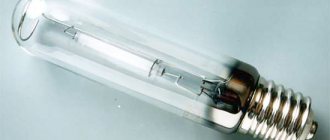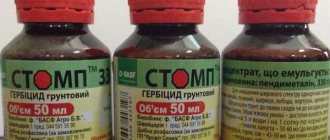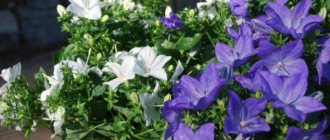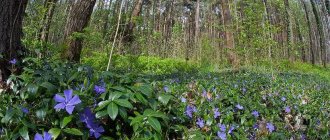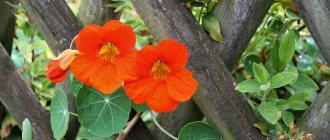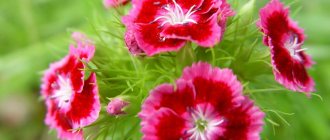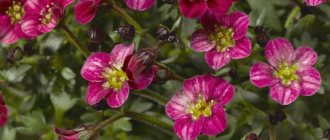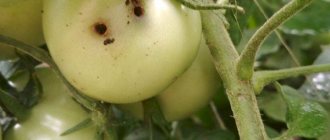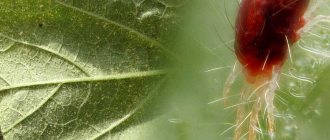Greenhouse / Fertilizer and agrochemicals
What is a continuous herbicide?
According to the conditions of use, continuous action herbicides are divided into a number of subgroups: pre-emergence, soil, post-emergence and foliar. Leaf preparations are absorbed by the above-ground parts of plants. Soil products are absorbed by roots, seeds, and seedlings.
- 1 Non-selective herbicides and their types 1.1 Effect of a systemic herbicide
- 1.2 Effect of contact drugs
- 3.1 Pre-emergent products
Advantages and disadvantages
Advantages and disadvantages
Application in areas where it is necessary to completely destroy vegetation, for example, on construction sites, near highways and railways, industrial facilities and airfields.
Application in spring, during the period of active development of weeds in gardens and fields.
Use before harvest as desiccant.
Application in the fall to prevent overwintering of weeds and reduce the number of shoots in the spring.
Disadvantages: continuous herbicides act on all plants at once; if used incorrectly, cultivated plants may also be damaged. Treatment is possible with plant protection.
Rules for choosing the best remedy
For professional farmers and use on personal plots, 4 dozen continuous action herbicides are produced. When choosing a means for treating an area, it is important to find an option that will least damage the soil and cultural plantings. It would be useful to familiarize yourself with the composition of the weed flora growing on the site. The preparations have a stable herbicidal effect against the weed groups specified in the instructions; the manufacturer’s recommendations should not be neglected.
For areas with green spaces, a product with a low level of phytotoxicity is chosen so as not to be left without cultural plantings. It is believed that systemic agents are more harmful to beneficial flora than contact ones.
Important: agronomists advise combating weeds in a comprehensive manner - using mechanical methods along with herbicides (weeding, mulching, covering with films).
Main types
Continuous herbicides are divided into 2 groups: contact and systemic. They differ in active substances and the way they act on weeds.
System
Substances from the drugs of the 1st group act on the surface of the above-ground part of the weeds on which they fall; they are resistant to precipitation and are fast-acting.
Contact
Substances from group 2 products enter plant tissues, roots and growing points and affect weeds from the inside. Systemic herbicides are highly effective against perennial weeds, including those with a strong root system.
Varieties
Herbicides are classified according to several criteria - method of action and application, according to target landmarks (for grass, shrubs, trees). When choosing a weed remover, you need to understand how it works and what results to expect.
Contact
These drugs, once on the surface of plants, adhere well to the stems and foliage, quickly penetrate inside the integument, and suppress growth points. Contact agents are not afraid of external influences - sun, precipitation, wind. The downside is that they do not reach the underground part, so weeds with a powerful root system soon sprout new shoots.
System
Systemic herbicides have a high penetrating ability - once on the plant, the drug begins to circulate throughout all its parts. Soil application of systemic preparations is especially effective; they are drawn in with moisture by the roots and destroy the entire plant.
Expert opinion
Zarechny Maxim Valerievich
Agronomist with 12 years of experience. Our best country expert.
Ask a Question
Such products are used in garden plots to remove perennial weeds with a powerful root system.
Rating of herbicides for weeds
Let's look at ten popular drugs known for their effectiveness, how to use them according to instructions and dosage. The products are often used not only in the fields, but also on personal farms.
See also
Instructions for use of Stomp and herbicide composition, dosage and analoguesRead
"Rap"
Contains glyphosate, one of the most powerful herbicidal substances. The application rate is from 2 to 8 liters per hectare. Spray fruit, vegetable, and industrial crops against vegetative weeds in the spring and summer or after harvesting. Consumption – 100-200 l/ha. Processing is one-time.
"Hurricane Forte"
Contains glyphosate. The application rate varies from 1.5 to 3.5 liters per hectare. Spraying weeds in the active growth stage and in the fall. Single treatment, liquid consumption - 200-300 l/ha.
"Tornado"
The active substance is glyphosate. The herbicide destroys over 150 types of unwanted vegetation. Concentration – from 25 to 75 ml per 3 liters of water, treatment during the season. They cultivate vineyards, orchards, lawns, fields for sowing crops, and areas near roads. Frequency of treatments – 1.
"Total"
The active ingredient is glyphosate. They cultivate fields for crops, gardens and non-agricultural areas. Concentration is from 2 to 8 liters per hectare, 200-300 liters of the resulting solution are consumed per hectare. Spraying is done once.
"Torch"
Also contains glyphosate as an active compound. Designed for cultivating fields for sowing winter and late spring crops, vineyards and fallows. Weeds are sprayed once in spring, summer and autumn, using 100-200 liters per hectare.
"Grader"
The active substance is imazapyr. Used on non-agricultural areas, rapeseed and sunflower. Concentration – 0.075-0.12 and 2-5 l per ha. Treatment of weeds in the early stages of development and actively growing ones. Solution consumption is from 50 to 300 liters per hectare. Frequency of application – 1, waiting period for sunflower and rapeseed – 2 months.
"Roundup"
The herbicide contains glyphosate. It is used in the spring to control 1-year and perennial weeds that infest spring crops. Processing is done no later than 3-5 days before sowing or before the formation of crop shoots. Concentration – 20-40 ml per 3-4 liters of water. Spend this volume per 50-100 sq. m. area.
"Glyphosate Wolnik"
The active compound is glyphosate. They cultivate fields for sowing various crops, non-agricultural areas and fallows during the period of active weed development and in the fall. The treatment is done once, using 100-200 liters of solution per hectare.
See also
Instructions for use of Reglon Air, desiccant dosage and analoguesRead
"Arsenal"
The active compound is imazapyr. Destroys weeds and trees and shrubs in local areas, near gas stations, railway roads, fences, power lines. Application rate: for spraying bushes, 15 ml/5 l of water; for treating trees, inject the same volume of the drug under the bark with a special syringe.
"Octopus"
The herbicide contains glyphosate. They cultivate non-agricultural plots, fallows and fields intended for sowing various crops. Application rate – 1.4-2.5 l, 1.4-2.8 l, 2.5-4 l, 2-3 l, 3-5 l. Spraying time - before germination and during active growth, consumption - 100-200 liters per hectare. Frequency of spraying – 1.
Prices
Farmers respond positively to the above herbicides, noting their effectiveness in the fight against harmful weeds. In addition, their prices are reasonable and affordable for farmers.
For example, the average cost for 1 liter in rubles is:
- Glyphosate – 375;
- Napalm - 271;
- Typhoon - 220;
- Octopus - 672;
- Roundup – 520;
- Tornado – 630;
- Anti-weed – 471;
- Arsenal – 320;
- Agrokiller – 1100;
- Hurricane – 650;
- Grader – 356;
- Torch – 310;
- Helios – 450.
Prices are not final and differ depending on the manufacturer, region of trade markup.
As you can see, the list is wide and varied, and most importantly, accessible. Drugs from this list are sold in stores, shopping centers, and on the Internet.
Precautionary measures
Work with continuous herbicides should be carried out only with the use of special clothing and protective equipment. Be sure to wear plastic goggles, a respirator and gloves. The duration of work with a pesticide solution should not exceed 6 hours, in private farms - 1 hour. It is prohibited to eat, smoke and drink, and remove personal protective equipment until the work is completed.
If the solution gets on your skin, face, or eyes, immediately rinse the area with clean running water. If there are symptoms of intoxication, consult a doctor.
Continuous action herbicides are used in cases where it is necessary to quickly and effectively get rid of seedlings and adult weed plants. They cultivate not only fields, fallows, orchards, but also often non-agricultural lands and territories. Usually, 1 treatment is sufficient to completely destroy weeds. Spraying is carried out at any time of the season: before sowing, after it, for weeds in the early stages of growth, for actively growing weeds and in the fall, when the crop is harvested. This makes continuous herbicides truly versatile.
Application of continuous action herbicides
Since there are quite a lot of continuous action herbicides, you need to clearly decide which of the preparations is suitable in a particular case. The choice is influenced not only by the types of weeds, but also by the general contamination of the site.
Drugs in this group are most often used in the following cases:
- For processing agricultural areas: fields intended for sowing grain, post-harvest processing, as well as weed control in summer cottages.
- In horticulture: to clear weeds from the rows of fruit trees and shrubs, as well as to eliminate weeds in vineyards.
- For cleaning non-agricultural lands: city parks and squares, areas along major highways, railway tracks and runways, as well as under power lines.
- In shipping: to eliminate algae that interfere with the passage of ships.
The use of such chemicals also depends on the type of weeds they affect. For example, to get rid of annual weeds, pre-sowing spraying is carried out, although in some cases treatment is allowed after harvesting. Perennial weeds are sprayed after harvesting, but if they are widespread, careful treatment of the row spacing of cultivated plants is allowed.
When using any herbicide, you must strictly adhere to the dosage and application rate specified by the manufacturer. Only in this case the effect of using the chemical will be positive.
Note: We must not forget about the toxicity of such products. Treatment should be carried out in dry, windless weather, and the air temperature should be within +16+25 degrees. In addition, it is necessary to wear a protective suit, goggles and a mask so that chemical particles do not accidentally come into contact with the skin, eyes or respiratory tract.
If there is a need to apply continuous action herbicides on already sprouted beds, it is better to use a sprayer with a small spray radius (jet). In this case, you will be sure that the chemical only hit the weeds and did not affect the cultivated plants.
Figure 2. Effect of drugs
After treatment, you need to thoroughly wash your hands and face with soap, rinse your mouth and nose with clean water, or take a shower.
It should also be remembered that some time must pass for the first signs of weed wilting to appear. On average, this figure is 5-7 days. During this period, you cannot carry out soil cultivation (loosening, cultivation), and if you have such an opportunity, then completely refrain from any work on the treated beds. Only when the symptoms of wilting are noticeable can you begin other work in the garden.
Content
- The most commonly used herbicide active ingredients
- TOP 5 effective groups of herbicides for gardening and vegetable gardens
- 1. Agrokiller / Tornado / Roundup / Glyphos, etc.
- 2. Lintur/Weeding
- 3. Gazontrel/ Lontrel/ /Lornet/ Hacker and others.
- 4. Deimos
- 5. Miura / Excellent student / Forward / Hunter and others.
- As a conclusion
This material provides a comparative analysis of the TOP-5 effective groups of herbicides (by chemical composition/active ingredient, purpose, dosage, and application features).
Herbicides are widely used not only in agriculture for the protection of cultivated plants and cleaning of irrigation systems, but also the sides of roads, railways, etc.
Recently, gardeners have been actively using herbicides to protect strawberry plantings from weeds, clear garden paths and lawns of plantain, dandelions, bindweed, and treat the perimeters of areas along fences from unwanted herbaceous vegetation.
Many questions arise, and so on, in order.
The most commonly used herbicide active ingredients
- Glyphosate (isopropylamine/potassium/sodium salt) - preparations “Agrokiller”, “Tornado”, “Uragan-Fote”, “Roundup”, “Chistogryad”, “Napalm”, Aristocrat”, “Ground”, “Glyphos”, “Liquidator” and etc.
- Dicamba (dimethylamine/diethylethanolammonium/sodium salt) - “Deimos”, “Propolol”, etc.
- Triasulfuron / chlorsulfuron - drugs “Lintur”, “Propolol”, etc.
- Clopyralid - drugs "Gazontrel", "Lornet", "Hacker", etc.
- Khizalofop-P-ethyl - drugs - “Olitschnik”, “Miura”, etc.
- Metribuzin - drug "Lazurit"
- Oxyfluorfen - the drug "Galigan" and others.
| MORE “Classification and mechanism of action of herbicides” |
Herbicides: concept, classification
Herbicides are chemical preparations that completely destroy or paralyze the growth of weeds. There are more than 1000 titles. Their advantages:
- Suitable for processing large areas.
- Effectively destroys weeds, better than manual weeding.
- Saves the farmer's time.
Minuses:
- Toxicity to beneficial microflora of soil, animals and humans.
- Improper use leads to a decrease in the quality of not only weeds, but also useful plants, up to their complete destruction.
- Frequent use of one type of herbicide against weeds increases their resistance to this drug.
- The production of herbicides is dangerous for the environment.
The classification of herbicides by type of action is extensive:
- All action. Destroy all types of vegetation in the desired area.
- Selective action. They only have a negative effect on specific types of plants.
- Above ground. Penetrate through aerial parts (stems, flowers, leaves)
- Ground. They destroy the plant by getting on its underground parts (roots).
- System. They penetrate inside, causing disruption of the plant’s life support systems, and act for a long time.
- Contact. They destroy plant tissue at the point of contact with the drug and act instantly.
There are 4 classes based on the degree of toxicity. 1 is the most dangerous, 4 includes the safest drugs.
Security measures
An experienced gardener will never work with any chemicals without protective equipment. Herbicides are no exception, so before using the product, prepare special clothing, a respirator, boots, goggles, and gloves in advance. They also carefully study the instructions.
Basic Rules:
- solutions are prepared in special containers, preferably outdoors. There should be no other people or pets nearby;
- work in calm, windless weather, observing the recommended regulations on the timing and timing of treatments;
- during work, exclude eating, drinking, smoking;
- After treatment, the remaining product is disposed of according to the instructions, the overalls are sent for washing, and be sure to take a shower.
Preparations and containers for preparing solutions are stored in inaccessible places.
It is also important to observe the deadlines for safe exits to treated areas:
- for products based on metribuzin and clopiralide - no earlier than three days;
- for products based on dicamba acid – after a week;
- for glyphosate-based products (Fighter only) - no earlier than two weeks.
It is necessary to observe the waiting period - the period between the time of processing and harvesting in the garden. All data is indicated in the instructions for the drugs and all that remains is to carefully study the provisions. It is unacceptable to treat plantings with herbicides excluded from the State Catalog and prohibited for use.
What types of weeds are there?
For the purposes of effective vegetable growing, weeds are classified according to their life cycle:
- Annuals: purple damselfish, chickweed (woodlouse), field violet, odorless chamomile, field cabbage, spreading and Tatarian quinoa, field forget-me-not, common cress, annual bluegrass, blue cornflower, field larkspur, Schleicher's fume, field mustard.
- Perennial: horse sorrel, common toadflax, common wormwood, horsetail, creeping wheatgrass, Geneva grass, mouse pea.
Annuals spread by seed and grow quickly and vigorously. Most of them are spring or wintering. The seeds survive the winter well and germinate actively in spring and summer. Pulling out such weeds is effective before the flowering and fruiting period.
But even this does not guarantee that weeds will not appear again from seeds carried by the wind, animals, or hatched from dormant grains.
Perennials are not as active, but are much more difficult to weed by hand. Even if you remove the plant by the roots, there is no guarantee that no pieces of rhizome remain in the soil.
And given that many of these weeds reproduce by dividing underground parts, it turns out that the gardener, by digging them up by hand, only contributes to their further spread.
Such plants can be defeated with persistence, every spring and autumn carefully sorting the soil and removing all pieces of rhizomes. But in large areas this is unrealistic.
